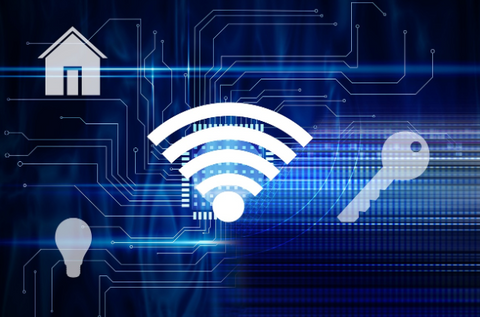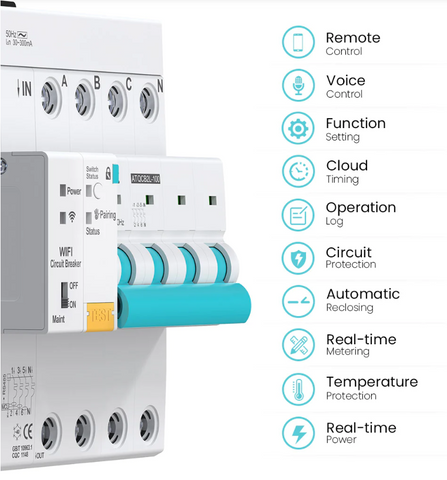3 Smart Breaker Trends You Might Be Overlooking

In an era defined by technological innovation and sustainability, the role of Smart Circuit Breakers in modern homes has become increasingly significant. Smart breakers, also known as intelligent circuit breakers, are revolutionizing the way we manage and interact with our electrical systems. Unlike their traditional counterparts, smart breakers offer a plethora of features that enhance safety, efficiency, and convenience within the household.
Overview of Traditional Circuit Breakers vs. Smart Breakers
Traditional circuit breakers have long been the stalwarts of electrical safety, serving as essential components that prevent overloads and short circuits. However, these conventional devices lack the intelligence and adaptability that characterize their smart counterparts.
Smart breakers go beyond mere electrical protection; they are equipped with advanced sensors, communication capabilities, and data processing functionalities. This big change helps them watch, study, and improve how they use electricity right away. It gives homeowners more control and understanding of their energy use.
Trend 1: Energy Monitoring and Management
A. Real-time Energy Consumption Tracking
Smart breakers excel in providing real-time energy consumption tracking. By using sensors and monitoring, homeowners can see how electricity is being used in their homes in real-time. This data can be accessed via smartphone apps or dedicated interfaces, empowering users to make informed decisions about their energy usage.
B. Integration with Smart Home Systems
One of the key advantages of smart breakers is their seamless integration with existing smart home systems. They can talk to other devices like thermostats, lights, and appliances, creating a smart system that responds to energy needs. This synergy enhances the overall efficiency of the home, reducing energy waste and lowering utility bills.
C. Benefits of Efficient Energy Management
Efficient energy management lies at the heart of smart breaker technology. Homeowners can set goals for energy use, get alerts for unusual patterns, and automate energy-saving actions based on criteria. This not only contributes to cost savings but also fosters a more sustainable and environmentally conscious lifestyle. Moreover, smart breakers contribute to the longevity of electrical appliances and systems by preventing overloading and reducing wear and tear.
Trend 2: Remote Control and Accessibility
A. Smartphone Apps for Breaker Control
With the advent of smartphone apps, controlling and managing your home's electrical system has never been more accessible. Smart breakers can be controlled from a distance using mobile apps. Users can turn circuits on/off, adjust power, and check energy usage easily on their phones.
B. Safety and Convenience of Remote Access
The safety and convenience of remote access to smart breakers cannot be overstated. Imagine being able to control the electricity in specific areas of your house when you're not there or during emergencies. This would help keep your property secure and prevent potential hazards. This level of control empowers homeowners to respond swiftly to unforeseen circumstances without needing to be physically present.
C. Use Cases for Remote Control
The use cases for remote control extend beyond emergencies. Homeowners can control energy use from a distance, distribute power efficiently, and set schedules that match their daily routines. Additionally, remote control enhances accessibility for individuals with mobility challenges, fostering inclusivity and independence.
Trend 3: Advanced Fault Detection and Alerts
A. Early Warning Systems for Electrical Issues
Smart breakers play a pivotal role in early warning systems for electrical issues. Equipped with sophisticated sensors, these breakers can detect anomalies such as voltage fluctuations, current surges, or overheating. When found, they can notify homeowners, so they can fix possible issues before they become bigger electrical problems.
B. Potential to Prevent Fires and Damage
The potential to prevent fires and minimize damage is a compelling feature of advanced fault detection. Smart breakers help prevent dangerous electrical situations by detecting abnormal patterns and behaviors that could cause circuit overloads or short circuits. This proactive approach significantly reduces the risk of fires and costly repairs.
C. Integration with Home Security Systems
Smart breakers can seamlessly integrate with home security systems, adding an extra layer of protection. When unusual electrical activity is detected, smart breakers can trigger alarms and notifications within the home security network. This integration not only enhances the safety of the household but also enables homeowners to respond promptly to potential security breaches.
Future Potential and Integration

A. Synergy with Renewable Energy Sources
Smart breakers hold immense potential in harnessing the power of renewable energy sources. They can intelligently manage the flow of electricity from solar panels, wind turbines, and other renewable sources, optimizing energy utilization and storage. This synergy contributes to a greener and more sustainable energy ecosystem.
B. Role in Smart Grids and Energy Distribution
Smart breakers are poised to play a crucial role in shaping the future of smart grids and energy distribution. They can talk to utility companies and change power distribution immediately. This can help balance energy supply and demand, reduce power outages, and improve the grid.
C. Integration with AI and Predictive Maintenance
Integrating artificial intelligence with smart breakers opens the door to predictive maintenance. AI algorithms can analyze data from the breakers to identify patterns indicative of impending faults, enabling proactive maintenance and reducing downtime. This predictive approach enhances overall system reliability.
VI. Overcoming Challenges and Considerations
A. Data Privacy and Security Concerns
The increased connectivity of smart breakers raises concerns about data privacy and security. Proper encryption protocols and robust cybersecurity measures must be in place to safeguard sensitive energy consumption data and prevent unauthorized access.
B. Compatibility with Older Electrical Systems
Adapting smart breaker technology to older electrical systems may pose compatibility challenges. Retrofitting solutions and clear guidelines for integration will be essential to ensure smooth adoption and functionality in diverse home environments.
C. Cost vs. Long-term Benefits
The initial investment in smart breakers may deter some homeowners, leading to considerations of cost-effectiveness over the long term. A comprehensive cost-benefit analysis should factor in energy savings, increased safety, and potential incentives to demonstrate the value proposition.
VII. Conclusion
The evolution of smart breakers represents a pivotal shift towards more efficient smart home devices. Embracing this transition enables homeowners to actively contribute to energy conservation and sustainability.
As we navigate the path towards a smarter future, it is crucial to encourage the adoption and raise awareness of smart breaker technology. By educating homeowners about the benefits and addressing potential concerns, we can drive widespread adoption and usher in an era of safer, more efficient, and environmentally conscious homes.
Contact:
AT-ELE
sale@at-ele.com
www.at-ele.com




